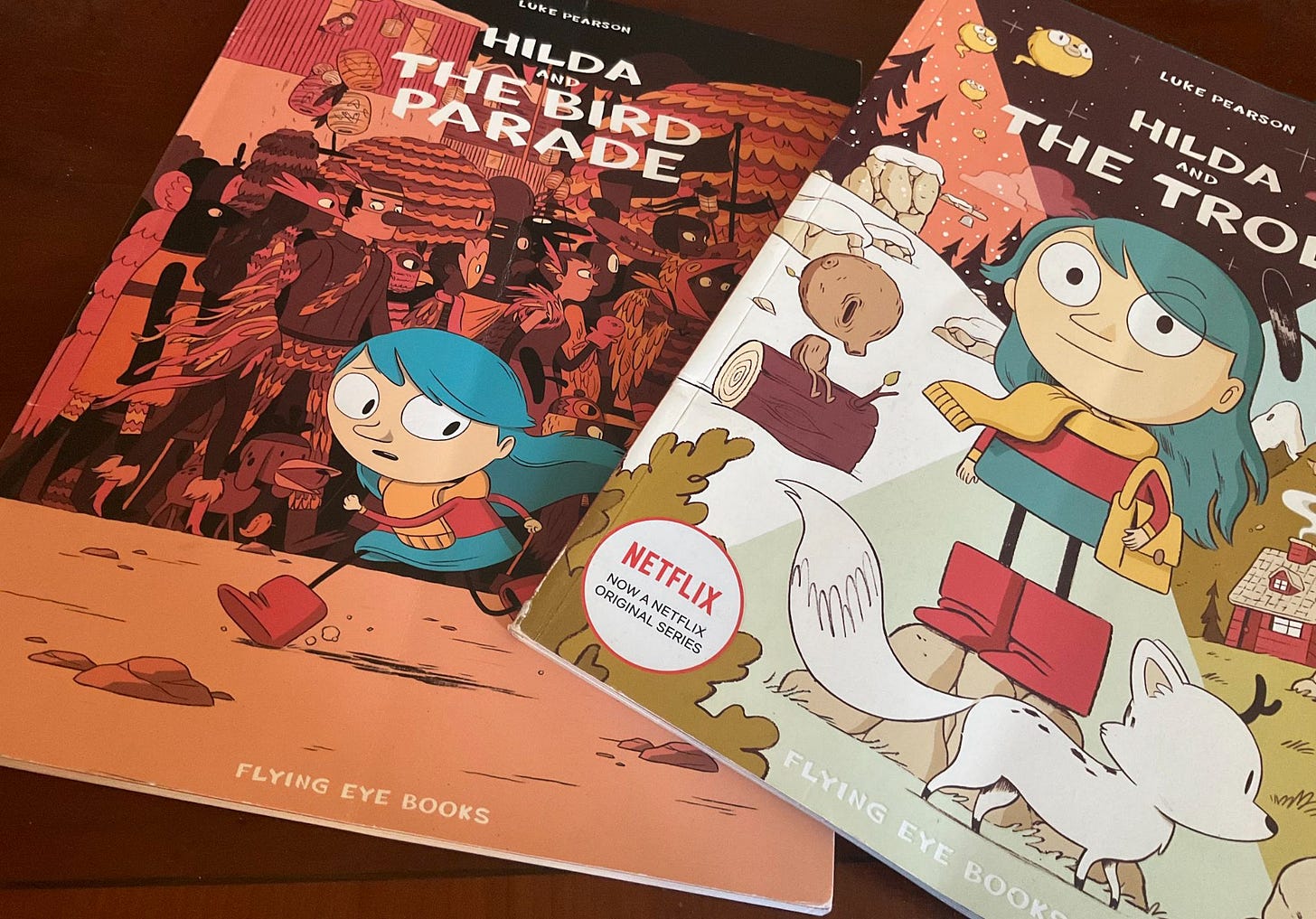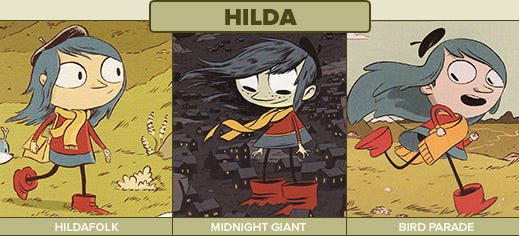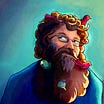How a Blue-Haired Adventurer Helps Us See the World
By guest writer John Lumgair
Please visit John’s substack: JazzCow.Substack.com
I was recently on a Zoom call with a bunch of creative types, and the conversation turned to films. It became clear that I lacked the encyclopaedic knowledge of everyone else. It was fascinating to listen to, but I didn’t have much to offer. I often feel the same way about comics—when I step into a comic shop, I have the feeling of a tourist lost in a foreign land— clutching a phrasebook and struggling to find the way to stories that resonate with me.
Which brings us to the matter at hand. This little article, you see, is for those who, like me, love comics but find themselves somewhat on the edge. Rather like someone who wanders into the theatre midway through the first scene unclear of what going on. I didn’t stumble upon the wonders of the comic series Hilda until a full decade after its debut, and only because Netflix kindly introduced us.
Hilda is a heartwarming collection of books by Luke Pearson, featuring a blue-haired girl whose spirit of adventure could be summed up in her own words:
“I don’t want to be small forever; I want to see the world.”
She lives with her mum, Joanna, in a remote cottage in the wilderness surrounded by mountains, forests, and magical creatures she befriends. Eventually, after a dramatic incident, they trade their rural home for the bustling city of Trolberg, where Hilda continues to discover a world more steeped in folklore than you might guess—provided you know where to look, of course. It’s a bit like that stage in life, around age five, when you seamlessly switch between “the real world” and a boundless realm of imagination, where both are equally real and vivid.
Like all the best tales, I get the impression that there’s much more beneath the surface of both the books and the animated series. You can be sure Pearson didn’t just pluck characters from the nearest available hat, but instead, he drew from Scandinavian folklore and history, creating an enchanted world that feels genuinely alive and authentic. It’s storytelling, that invites you in rather than bombarding you with flashing lights and loud noises.
The aesthetics of the comics
Hilda doesn’t quite fit into the mould of mainstream American comics or Japanese manga. No, she looks more at home in the European tradition with the likes of Tintin, Asterix, the Moomins, and Les Géants. The expressive lines but simpler flat colour resonate with me. When working on my own series, Jazz Cow (JazzCow.Substack.com), and collaborating with Selom Sunu to redesign Chris Cox’s original characters (mrchriscox.substack.com), many of our references we discussed came out of that same European design tradition. Hilda’s world offers simplicity and innocence without resorting to artificial sweeteners. Pearson’s skill with colour and his limited palettes don’t just look beautiful; they enhance the story’s mood.
The Netflix adaptation
As I mentioned, I stumbled upon Hilda through Netflix, and the first thing that grabbed me was the sheer quality of the animation. We’re talking about animation that makes an animator sit up and take notice. Some adaptations of comics don’t work, messing about with horrible line quality goofy redesign and dismal animation. But then there are the gems that get it right, staying true to their essence. Take The Adventures of Tintin, for example—wonderful stuff, it is well executed, it does the job admirably, but that’s where it stops. Hilda, on the other hand, takes things to the next level. The attention to detail and the sheer effort invested is more common for cinema than television.
Now, one thing I can’t go without mentioning is the way Hilda’s design shifts dramatically from comic to comic. In fact, when I first saw some images from the comics I thought they were crazy fan art. And I’m not talking about the subtle evolution of character design as you see with Tom and Jerry, but something much more dramatic. Normally, such inconsistency would have me raising an eyebrow, but with Hilda, I find it endearing. It’s as if each design change externalizes a different aspect of her personality, maybe it’s because I like her and I let her get away with more than I normally would. But how on earth does that translate to animation?
I once had the task of adapting an illustrated book for animation, the main character’s design changed so subtly from page to page that it was a decent amount of work to standardize him. But I can see with Hilda, that the challenge was on an entirely different level. Yet, the team managed to achieve what Disney animators Ollie Johnston and Frank Thomas refer to as “Appeal” in their 12 Principles of Animation. Like the charisma of a great actor—there’s a quality to Hilda’s design that keeps you engaged. These proportions and design choices add warmth and simplicity, making Hilda’s emotions easy to read and connect with. The redesign strikes the perfect balance between artistic interpretation and the character’s original spirit.
Hilda: The Character Between Worlds
All of this culminates in a delightful set of characters, with Hilda leading he charge—ever curious, navigating a world that straddles our modern reality, a realm of imagination, and a time when enchantment still lingered, where modern philosophy hasn’t yet conquered all mystery and magic. Paradoxically She wants to be big so she can see the world, but maybe in the process of becoming big, she risks losing the ability to see the world in full resolution. I get the impression that her Mum, Joanna once shared Hilda’s free spirit.
Last year I spoke to a lady who used to rush through a park on her way to work, so absorbed in her daily grind that she barely took note of the trees. But during lockdown, when her life slowed to a leisurely stroll, she found herself truly seeing each tree for the first time. We’re so caught up in modern materialism that we’ve forgotten to look up and appreciate the genuine magic around us.
Hilda, in her own charming way, nudges us to open our eyes and see the world afresh. Her adventures provide a shift in perspective like in the Irish folklaw-inspired animations of Tomm Moore, or Norse and old English-inspired books of Tolkien—creations that invite us to see the world not as a collection of mundane objects but as something alive, brimming with hidden wonders for those that care to look.
Please visit John’s substack: JazzCow.Substack.com









I need to get to know her better.